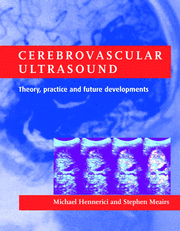Book contents
- Frontmatter
- Dedication
- Contents
- List of contributors
- Preface
- PART I ULTRASOUND PHYSICS, TECHNOLOGY AND HEMODYNAMICS
- 1 Introduction to Doppler ultrasound
- 2 Doppler technology
- 3 Principles and models of hemodynamics
- 4 Computational principles and models of hemodynamics
- 5 Flow patterns and arterial wall dynamics
- 6 Duplex and colour flow imaging
- 7 Misconceptions and artefacts in ultrasound examination of the carotid arteries
- PART II CLINICAL CEREBROVASCULAR ULTRASOUND
- PART III NEW AND FUTURE DEVELOPMENTS
- Index
1 - Introduction to Doppler ultrasound
from PART I - ULTRASOUND PHYSICS, TECHNOLOGY AND HEMODYNAMICS
Published online by Cambridge University Press: 05 July 2014
- Frontmatter
- Dedication
- Contents
- List of contributors
- Preface
- PART I ULTRASOUND PHYSICS, TECHNOLOGY AND HEMODYNAMICS
- 1 Introduction to Doppler ultrasound
- 2 Doppler technology
- 3 Principles and models of hemodynamics
- 4 Computational principles and models of hemodynamics
- 5 Flow patterns and arterial wall dynamics
- 6 Duplex and colour flow imaging
- 7 Misconceptions and artefacts in ultrasound examination of the carotid arteries
- PART II CLINICAL CEREBROVASCULAR ULTRASOUND
- PART III NEW AND FUTURE DEVELOPMENTS
- Index
Summary
Christian Andreas Doppler
Christian Andreas Doppler was born in Salzburg on 29 November 1803. Although he is usually referred to as Johann Christian Doppler, Eden (1988) shows that this mistake probably originated from a misreading of his original birth record where his father's Christian name was confused with that of the son. Doppler was appointed to the position of Supplementary Professor of Higher Mathematics and Practical Geometry at the Technical Institute in Prague in 1838 and was made a full Professor in March 1841.
Doppler was interested in the colour of stars and in the wave theory of light. He pointed out that the colour of the star perceived by the eye depended on the frequency of the light emitted by the star. He then postulated that the frequency will increase if the observer is moving towards the light source, and will decrease if it moves away. Unfortunately, Doppler made the mistaken assumption that all stars emit white light. He further stated that, because of this, blue stars must be moving towards the observer, and red stars must be moving away. It was shown by quantum theory, however, in the late nineteenth century, that the peak energy in the radiation spectrum emitted by black bodies is determined by the temperature of the source. For this reason, hot stars appear blue and cool stars appear red.
- Type
- Chapter
- Information
- Cerebrovascular UltrasoundTheory, Practice and Future Developments, pp. 3 - 15Publisher: Cambridge University PressPrint publication year: 2001



